Hälsingland is a rural region on the Baltic Sea coast in the east of Sweden. Hälsingland is renowned for its decorated wooden farmhouses. The farmhouses represent the Scandinavian timber building tradition. The farmhouses of Hälsingland were built in the 19th century and reflect the prosperity and wealth of the independent farmers. A decorated porch has become a distinguishing characteristic for the decorated farmhouses of Hälsingland. Many farmhouses had a large, ornate room for gatherings and special occasions. The interior is lavishly adorned with paintings and printed wallpapers, the decorations are a blend of folk art, Baroque and Rococo styles. Nowhere else in the world do we find such a concentration of farmhouses with large wooden buildings and colourful decorated interiors. Red paint using pigments from the Great Copper Mine in Falun was also used in Hälsingland. Today, there are about thousand historic wooden farmhouses preserved in Hälsingland. Only seven decorated farmhouses of Hälsingland became a UNESCO World Heritage. The decorated farmhouses of Hälsingland on the UNESCO World Heritage List are: Kristofers farm in Järvsö, Gästgivars farm in Vallsta, Pallars farm in Långhed, Jon-Lars farm in Långhed, Bortom Åa farm in Fågelsjö (also known as Fågelsjö Gammelgård), Bommars farm in Letsbo, Erik-Anders farm in Askesta close to Söderala. Seven Decorated Farmhouses of Hälsingland gained the status as a UNESCO World Heritage in 2012.
www.werelderfgoedfotos.nl © Copyright World Heritage Photos
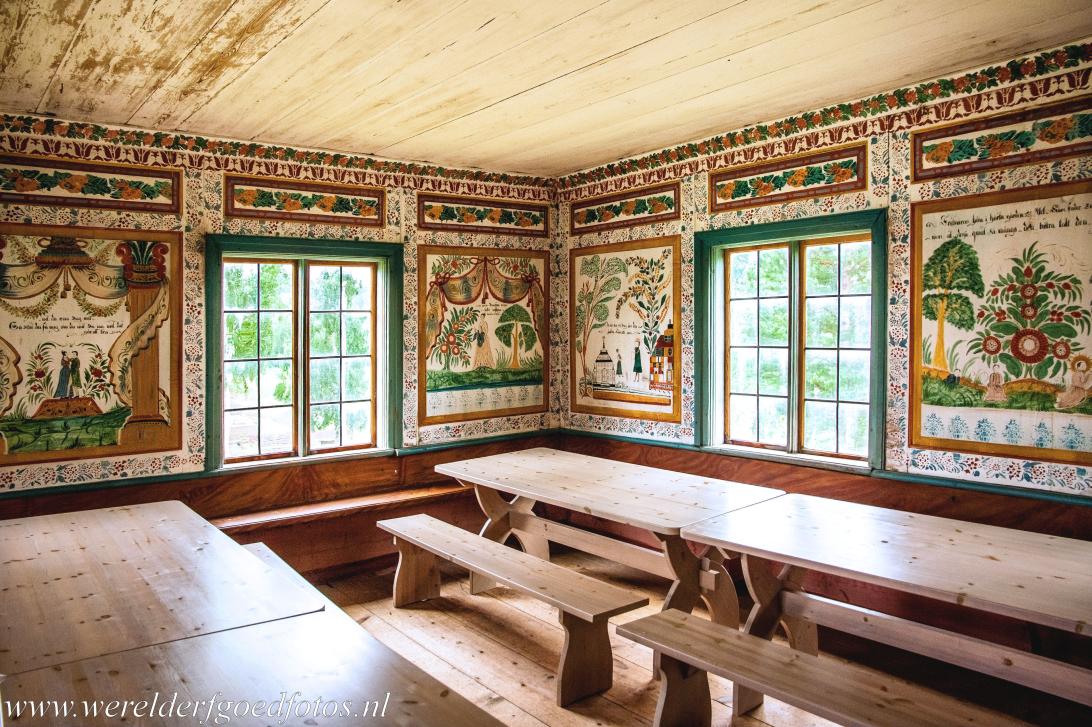
Decorated Farmhouses of Hälsingland: The ornate room was excessively decorated to impress visitors. The interiors of the farmhouses of Hälsingland are decorated with printed wallpapers and wall paintings. The colourful wall paintings and wallpapers existed side-by-side in the 1850s, they could be found in the same farmhouse, but in different rooms. Now, Hälsingland is famous for its decorated wooden farmhouses. The Decorated Farmhouses of Hälsingland were declared a UNESCO World Heritage in 2012.

Decorated Farmhouses of Hälsingland: The ornate room was excessively decorated to impress visitors. The interiors of the farmhouses of Hälsingland are decorated with printed wallpapers and wall paintings. The colourful wall paintings and wallpapers existed side-by-side in the 1850s, they could be found in the same farmhouse, but in different rooms. Now, Hälsingland is famous for its decorated wooden farmhouses. The Decorated Farmhouses of Hälsingland were declared a UNESCO World Heritage in 2012.
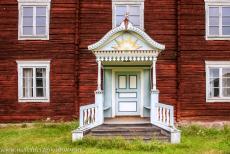
Decorated Farmhouses of Hälsingland: A fine decorated porch of a wooden farmhouse. The independent farmers of Hälsingland liked to impress their guests. Seven decorated farmhouses of Hälsingland were inscribed on the UNESCO World Heritage List in 2012. Of the approximately one thousand still existing farmhouses, these seven decorated wooden farmhouses represent a prominent historical building tradition that can be found throughout the whole of the Swedish province of Hälsingland.
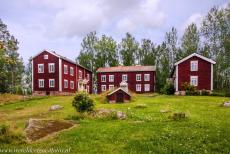
The decorated farmhouses of Hälsingland are situated in Central Sweden. The farmhouses of Hälsingland were built in the 19th century, they were constructed on drained and stony hills. A wooden farmhouse usually consist of three detached wooden buildings, placed in a U-shape, surrounded by several small wooden buildings to store food and goods. Nowhere else in the world do we find such a concentration of large wooden farmhouses with decorated interiors and decorated wooden porches.
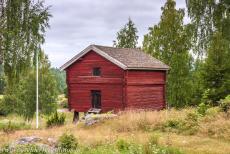
Decorated Farmhouses of Hälsingland: The farmhouses are surrounded by wooden sheds for the storage of goods. The farmhouses of Hälsingland represent the regional timber building tradition. They reflect the prosperity and the wealth of the independent farmers. Hälsingland is known as the most forested province of Sweden, the timber industry was an important source of income for the farners of Hälsingland. Hälsingland is situated in central Sweden, about 250 km north of Stockholm.
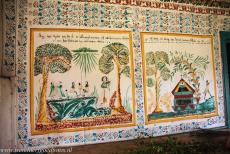
Decorated Farmhouses of Hälsingland: The interior of the farmhouses of Hälsingland were decorated with colourful paintings, a fusion of folk art, Baroque and Rococo styles. The farmers of Hälsingland used decorative paintwork in their interiors as well as on their wooden furniture. Sometimes wall paintings were made to resemble silk wall hangings. Some patterns were made by stencilling, a traditional technique to produce highlights and shading effects. On the outside, the farmhouses are plain wooden buildings, painted in Falun red.
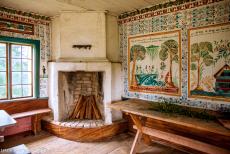
Decorated Farmhouses of Hälsingland: Most of the wooden farmhouses had a large, ornate room for special occasions and gatherings, this room was usually larger and more elaborately decorated than the other rooms in the farmhouse. The farmhouses of Hälsingland were built in the 19th century. The decorated farmhouses of Hälsingland reflect the prosperity and wealth of independent farmers, who had amassed a considerable fortune with forestry and growing flax to produce linen. The production of linen was a traditional craft in Hälsingland.
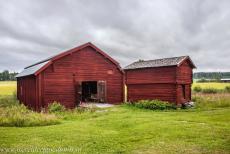
Decorated Farmhouses of Hälsingland: The main buildings of the farmhouses of Hälsingland are surrounded by several large or small wooden buildings for storage of goods. The external walls of the farmhouses were painted with Falu Rödfärg, the traditional Swedish dark red paint using pigments from the Falun Copper Mine. To prevent animals from accessing the stored food and goods, the wooden barns of wooden farms of Hälsingland were placed on either staddle stones or a stone foundation.
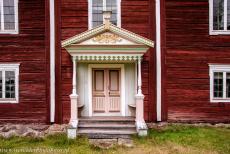
Decorated Farmhouses of Hälsingland: In the 18th and 19th centuries, the majority of the independent farmers of Hälsingland used their wealth to build imposing wooden farmhouses. A decorated porch has become a distinguishing characteristic for the decorated farmhouses. Of a total of approximately one thousand remaining farmhouses of Hälsingland, about fifty of them can be visited. Only seven of these decorated farmhouses were inscribed on the UNESCO World Heritage List.
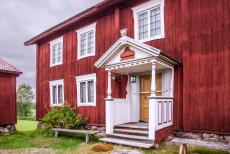
In 2012, seven Decorated Farmhouses of Hälsingland were inscribed on the UNESCO World Heritage List: Kristofers farm in Järvsö, Gästgivars farm in Vallsta, Pallars farm in Långhed, Jon-Lars farm in Långhed, Bortom Åa farm in Fågelsjö, also called Fågelsjö Gammelgård, Bommars farm in Letsbo and Erik-Anders farm in Askesta village close to Söderala, the Bortom Åa farm in Fågelsjö is situated just across the border in the province of Dalarna. These unique decorated farmhouses date mainly from the 18th and 19th centuries.
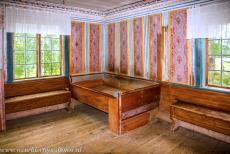
The Ol-Anders Farmhouse is a Visitor Centre for the UNESCO World Heritage Decorated Farmhouses of Hälsingland. The visitor centre is situated near the village of Alfta in Hälsingland. The farmhouse of Ol-Anders dates back to 1575, the farmhouse was severely damaged by a fire in 1793 and rebuilt in its current location. Most of the decorated farmhouses of Hälsingland are privately owned and only open to visitors during the summer months or on special occasions. The Ol-Anders Farmhouse is not included on the UNESCO World Heritage List.
